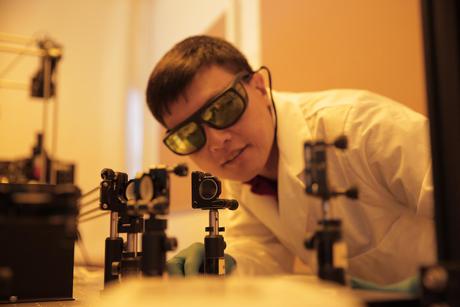Tiny sideways solar systems

Engineers from the University of Wisconsin–Madison have created high-performance, microscale solar cells that are said to outperform comparable devices. Unlike rooftop photovoltaic arrays, which generate electricity from charges moving vertically, the small cells capture current from charges moving side to side, or laterally — and generate significantly more energy than other sideways solar systems.
Top-down photovoltaic cells are made up of two electrodes surrounding a semiconducting material, like slices of bread around the meat in a sandwich. When light hits the top slice, charge travels through the filling to the bottom layer and creates an electric current.
In this arrangement, one layer needs to do two jobs: it must let in light and transmit charge. Therefore, the material for one electrode in a typical solar cell must be not only highly transparent, but also electrically conductive. Very few substances perform both tasks well.
Instead of building its solar cell sandwich one layer at a time, the UW–Madison group created a densely packed, side-by-side array of miniature electrodes on top of transparent glass. The resulting structure — akin to an entire loaf of bread’s worth of solar-cell sandwiches standing up sideways on a clear plate — separates light-harvesting and charge-conducting functions between the two components. Their research has been published in the journal Advanced Materials Technologies.
“From a fabrication point of view, it is always going to be easier to make side-by-side structures,” said Professor Hongrui Jiang, corresponding author on the paper. “Top-down structures need to be made in multiple steps and then aligned, which is very challenging at small scales.”
Furthermore, the team managed to surpass other approaches to synthesising sideways solar systems, which tend to rely on complicated internal nanowires or expensive perovskites and fall short on multiple measures of solar cell quality. Existing lateral solar cells convert 1.8% of incoming light into useful electricity, while Professor Jiang’s group achieved up to 5.2% efficiency.
“In other structures, a lot of volume goes wasted because there are no electrodes or the electrodes are mismatched,” explained Professor Jiang. “The technology we developed allows us to make very compact lateral structures that take advantage of the full volume.”
Packing so many electrodes into such a small volume boosted the devices’ ‘fill factors’, a metric related to the maximum attainable power, voltage and current. The structures realised fill factors up to 0.6 — more than twice the demonstrated maximum for other lateral new-generation solar cells.
The researchers are now working to make their solar cells even smaller and more efficient by exploring materials that further optimise transparency and conductivity. In the future, they foresee their miniature solar panels powering personal devices including wearable medical sensors, smartwatches and even autofocusing contact lenses.
Predictive AI model enhances solid-state battery design
ECU researchers are working on ways to make solid-state batteries more reliable with the help of...
Boosting performance of aqueous zinc–iodine batteries
Engineers from the University of Adelaide have enhanced aqueous zinc–iodine batteries using...
Sodium-ion battery breakthrough boosts energy storage
Scientists have discovered that leaving water inside a key material, rather than removing it,...




